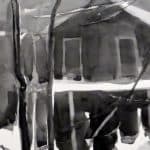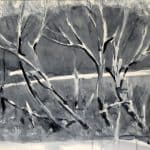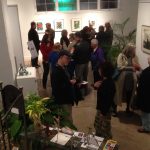
We usually think of “texture” as a device to explain the surface qualities of the forms and planes in our painting. But texture can play an important part in composition, in various ways. “Black Willow,” (above: watercolor on rag drawing paper, 22” X 30”) is an example.
A group of willow trees in a waste area beside Rte. 81 in Chinchilla, Pennsylvania. The trees are the “subject,” especially the graceful upper parts, with the front light from above making a quirky pattern of small, dark shadows. The two big sections of middle value represent the hill on the other side of the highway, and down below, the scrubby meadow where the willows grow.
I kept the big hill piece behind the trees smooth, without descriptive texture, for two reasons. One, to make that area stay back in space, and two, so that it would be an effective foil for the pattern of illuminated branches and shadows in front of it, and not compete.
The bottom piece includes the lower trunks of the willows, but also a jumble of downed branches and defunct fence-posts and weedy growth. I used a variety of techniques to express texture in that area, including rough-brush work, spatter, scraping, and brush line, to provide a context for the jumble of branches and to keep them from looking isolated and busy. The textural work also helped to bring that area forward, as compared to the similar large dark piece above
As you might expect, shape and value carry the ball in this picture…but deliberately orchestrated texture helps out.



